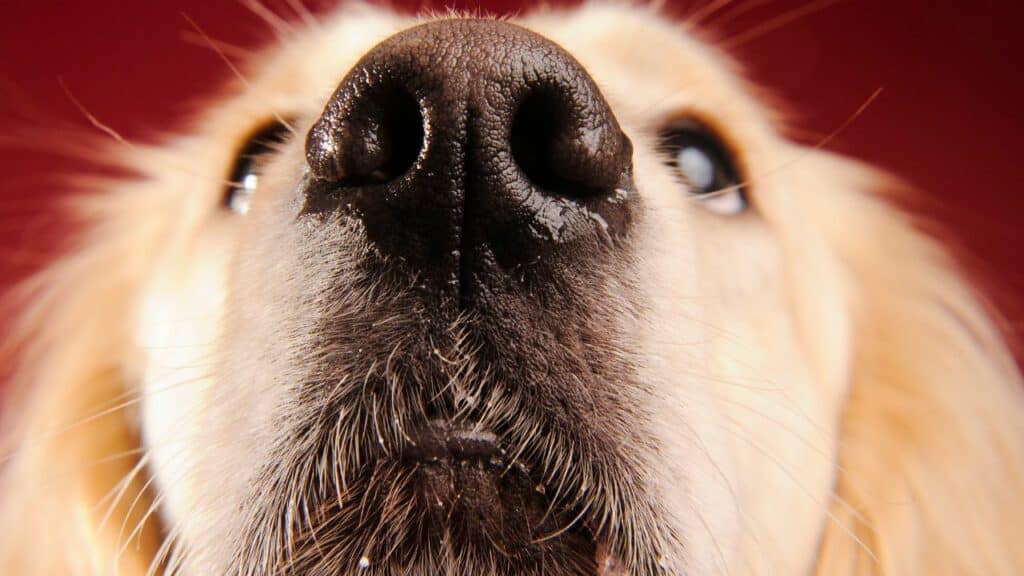The ability of dogs to detect disease in humans may surprise you.
Yes, dogs smell sickness.
They are able to detect changes in a person’s distinctive smell caused by illness.
Therefore, you should watch a countdown of diseases dogs can detect if you have a dog and a family history of serious illnesses.
If you suffer from a special illness, it could help to train your dog or look for one of the medical detection dogs.
Those dogs are trained to disease sniff dogs.
You now know the answer to the question “can dogs smell sickness?”, continue reading to get to know how dogs know that you’re sick and get to know the 8 diseases, dogs can recognize.
How To Tell If Your Dog Knows You’re Sick

For various reasons, your dog can detect disease and will let you know by exhibiting particular behaviors when you’re around.
First, your dog will appear unusually affectionate and adore you more than usual.
If your dog keeps attempting to lie down on the bed or couch with you, place its head in your lap, or otherwise be close to you when you are ill, they are trying to comfort you more and let you know that they are there for you.
Your dog may act a little more submissively around you, be less demanding during walks and playtime, and may even pull less or be less eager while out for a stroll if they sense that you are feeling under the weather.
Because they are aware of your extreme exhaustion and low energy level, they act in this manner.
When you’re unwell, your dog wants to cheer you up, provide comfort, and help you feel less stressed.
That is how they try to do it.
They take your cues to heart and modify their behavior accordingly.
Canines Can Detect Cancer
Unbelievably, dogs can identify cancers in a person’s body only by sniffing them, including lung cancer, bladder cancer, breast cancer, prostate cancer and skin cancer.
Dogs can pick out cancerous tissues from various samples and therefore accurately detect cancer.
Cancer cells emit a distinct odor that is absent in healthy ones.
Dogs can have up to 250 million scent receptors compared to humans’ 5 million, giving them an advantage in detect cancer.
It only gets more intriguing from here.
In the UK, a group called medical detection dogs trains dogs to detect the aroma of cancer in samples like breath, urine, and swabs.
The second intriguing piece of proof is based on a report from the Canada Free Press.
A mole on a woman’s thigh was attempted to be a bit off by the owner’s dog.
She had other moles, but he only focused on one.
Additionally, it was discovered to be a malignant melanoma.
According to a 2019 study in an experimental biology journal, dogs can reliably identify blood samples from confirmed cancer patients with 99% accuracy.
Which then also makes it possible to detect lung cancer, bladder cancer, breast cancer and prostate cancer.
Diabetics: Dogs Can Recognize Low Blood Sugar Level

Dogs are specially trained to warn their owners when their blood sugar levels are low.
The scientific basis is the discovery that dogs can detect the molecule isoprene in human breath.
When a person’s level drops, the volume of their breath increases.
According to today’s medical news, a dog that has been properly trained can detect this and alert its owner.
According to a 2013 study published by the Public Library of Science, these dogs have significantly extended the lives of diabetics who rely on insulin. Now number three on our list will shock you.
Depending on their level of training, dogs that can detect blood sugar drops typically respond with body language that manifests as pain or fear.
If the animal has been specifically trained to detect hypoglycemia, it might respond by snapping its paws for your attention or jumping on your knee.
Below are some general signs to look for in a dog experiencing a shift, although they may vary somewhat depending on the dog and the training.
Dogs typically nudge and bark to wake their owners.
Dogs may begin to protect their owners when they are unconscious and untrained but still sense this change.
When the dog senses an impending change in blood sugar levels, it will likely be very alert and nervous, which will show in the animal’s general behavior.
This attitude will likely manifest as worry or fear.
It is important to understand the dog’s body language to train him to alert you to low blood sugar and to make sure you do not miss the warning signs.
Different breeds of dogs can show different symptoms, and some can detect changes in better than others.
Because of their size and ability to learn quickly, retrievers and Labradors are often used as detection dogs.
Dogs Can Detect The Beginning Of A Migraine
Research by Psychology Today involved more than 1000 dog owners who suffer migraines.
They discovered that roughly one or two hours before the migraine began, 54% of dog owners noted a change in the behavior of their dogs.
There are service dogs that can detect migraines, believe it or not.
They can make the difference between having a migraine for three days and being able to successfully manage it if they notify you in time.
What is their method?
Dogs can detect it, just like they can with any other medical condition.
That is because serotonin spikes when a migraine is imminent.
Dogs can detect this and will bark at you to let you know.
We now have a few more on our list of unusual medical conditions that dogs can help with.
Migraine sufferers are too aware of the importance of treating migraines in their early stages to prevent hours or even days of excruciating pain.
Fortunately, some dogs can detect the warning signs of an approaching migraine.
The Migraine Relief Center claims that dogs can detect the prodrome phase of an attack, the beginning of the intricate migraine cycle, which typically starts 48 hours before the onset of the headache itself.
Yelling, food cravings, mood swings, diminished concentration, exhaustion, frequent trips to the bathroom, hyperactivity, and either constipation or diarrhea may be symptoms.
Like drug detection dogs who work in airports, dogs trained to recognize these symptoms utilize their keen sense of smell to identify changes in body chemistry and alert their owners by nudging, licking, circling, barking, or fixedly gazing at them.
Canines Can Detect Malaria

Malaria may not be widespread everywhere, but it can be fatal, especially for young children, in the countries where it still exists.
But once more, our well-trained, nosey service dogs come to the rescue.
Recent research proves that dogs can accurately tell if someone has malaria simply by smelling their socks.
Even if someone is not showing symptoms, the dog knows well ahead of time when someone has the disease. That can mean the difference between life and death.
Dogs Understand Fear And Stress
Researchers were right to hypothesize that dogs would react differently to human smells released during various emotional states, specifically fear and delight.
Three stimuli were used to train the dogs in the experiment: their owner, a stranger (the control), and an odor dispenser.
Dogs were randomized into various smelling situations.
They gathered scents from people in the three emotional states of fear, happiness, and neutrality (no sweat).
The smells were taken from the underarms of male donors who were chosen randomly and were not otherwise involved in the experiment’s procedures.
The dogs were then watched for reactions, such as actions toward the three targets, stress-related actions, and heart rates.
The dogs engaged more with the stranger and had lower heart rates when exposed to “pleasant scents,” according to the research.
The fight, flight or freeze response is a physiological response of the autonomic nervous system that is crucial for adaptation and survival.
However, when the dogs were exposed to the “fear odor,” they showed more stress behaviors and had higher heart rates.
The dogs were less social with the stranger and more reliant on their owners for assurance than the dogs exposed to the “happy odor.”
According to research, chemosignals, or the smells we release in response to our emotional state, communicate with dogs across species.
Therefore, if we are afraid, they can also smell it and become so scared.
Dogs Can Be Taught To Assist People With Narcolepsy
A severe disorder, narcolepsy.
A person can doze off at this point, even standing up.
When an attack is imminent, narcolepsy service dogs can tell by a change in the aroma of your sweat.
A 2013 scientific study published by the National Institutes of Health demonstrated this.
In the study, trained narcoleptic service dogs identified 11 out of 12 narcoleptic patients by smelling sweat samples.
In this situation, a trained service dog can notify the owner of upcoming episodes based on biochemical changes in the owner’s body.
That can prevent someone with narcolepsy from suffering significant harm.
The ability of canines to identify potentially fatal human diseases may surprise you.
Therefore, you should watch a countdown of eight ailments dogs can detect if you have a dog and a family history of serious illnesses.

Seizures
The canine response to epileptic seizures has not received enough scholarly attention.
16 Although there is anecdotal evidence that some dogs can and do recognize the beginning of an attack, most of this has come from small samples and subjective owner surveys.
Uncertainty still exists regarding the accuracy and, more importantly, our capacity to train dogs to warn their handlers of impending seizures.
The ability of dogs to recognize specific seizure-beginning indicators, such as smell, is still unknown to scientists.
However, we can teach canines how to react and help a handler when a seizure happens.
If the handler pays close attention to the signals the dog gives, some service dogs paired with seizure patients learn to recognize the signs of impending seizures and can provide an alert.
A small study conducted on five dogs in 2019 showed that the dogs could tell the difference between a patient’s odor when they were having an epileptic seizure and when they weren’t.
17 Researchers recognize that much more extensive testing would need to be done to see whether dogs could genuinely predict attacks before they happened and if other dogs would respond similarly.
That is because the study only used a small number of dogs and previously gathered odor samples.
When a seizure is detected, a dog may yelp or paw at the owner, acting differently than usual.
The owner would need to have a strong bond with the dog to recognize the difference because these could be highly subtle signs.
Some dogs can help the owner during a seizure but may not be able to sense one starting.
They will remain by their owner’s side, standing or lying next to them and occasionally licking their face.
Dogs Can Detect Parkinson’s Disease
A super-sniffing dog in England picked up on a change in his owner’s odor.
Parkinson’s disease, a movement-related condition of the neurological system, was discovered in him six years earlier.
That sparked an academic study at Manchester University to teach other dogs how to recognize Parkinson’s disease before the condition’s well-known symptoms manifested.
Canines have been trained to detect the smell of Parkinson’s disease since 2016 by a group called Parkinson’s Alert Dogs.
Conclusion: Can Dogs Smell Sickness

Before You Go…
Now you know the answer to your question: “Can dogs smell sickness?”.
If you want to learn more, read the following articles too!


